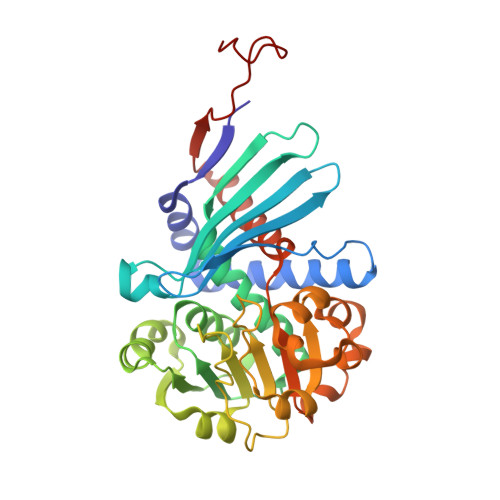Structural Basis for Recognition of L-lysine, L-ornithine, and L-2,4-diamino Butyric Acid by Lysine Cyclodeaminase.
Min, K., Yoon, H.J., Matsuura, A., Kim, Y.H., Lee, H.H.(2018) Mol Cells 41: 331-341
- PubMed: 29629557
- DOI: https://doi.org/10.14348/molcells.2018.2313
- Primary Citation of Related Structures:
5YU0, 5YU1, 5YU3, 5YU4 - PubMed Abstract:
L-pipecolic acid is a non-protein amino acid commonly found in plants, animals, and microorganisms. It is a well-known precursor to numerous microbial secondary metabolites and pharmaceuticals, including anticancer agents, immunosuppressants, and several antibiotics. Lysine cyclodeaminase (LCD) catalyzes β-deamination of L-lysine into L-pipecolic acid using β-nicotinamide adenine dinucleotide as a cofactor. Expression of a human homolog of LCD, μ-crystallin, is elevated in prostate cancer patients. To understand the structural features and catalytic mechanisms of LCD, we determined the crystal structures of Streptomyces pristinaespiralis LCD (SpLCD) in (i) a binary complex with NAD + , (ii) a ternary complex with NAD + and L-pipecolic acid, (iii) a ternary complex with NAD + and L-proline, and (iv) a ternary complex with NAD + and L-2,4-diamino butyric acid. The overall structure of SpLCD was similar to that of ornithine cyclodeaminase from Pseudomonas putida . In addition, SpLCD recognized L-lysine, L-ornithine, and L-2,4-diamino butyric acid despite differences in the active site, including differences in hydrogen bonding by Asp236, which corresponds with Asp228 from Pseudomonas putida ornithine cyclodeaminase. The substrate binding pocket of SpLCD allowed substrates smaller than lysine to bind, thus enabling binding to ornithine and L-2,4-diamino butyric acid. Our structural and biochemical data facilitate a detailed understanding of substrate and product recognition, thus providing evidence for a reaction mechanism for SpLCD. The proposed mechanism is unusual in that NAD + is initially converted into NADH and then reverted back into NAD + at a late stage of the reaction.
- Department of Chemistry, College of Natural Sciences, Seoul National University, Seoul 08826, Korea.
Organizational Affiliation:



















